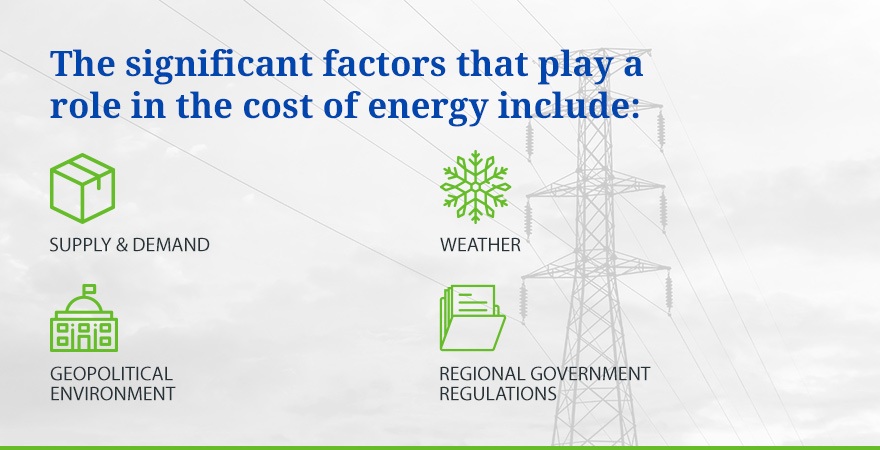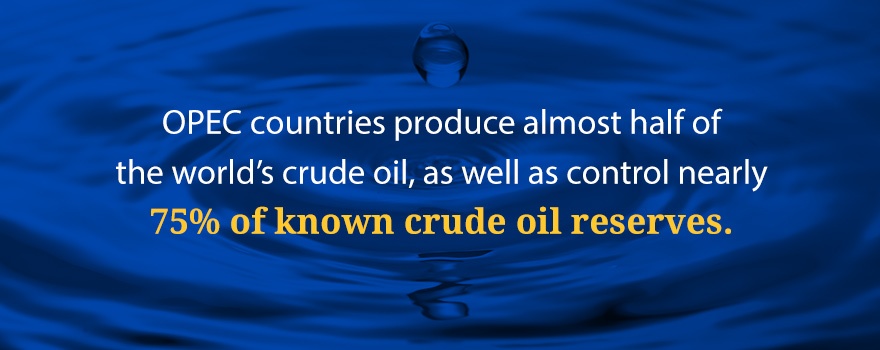At times, the forces driving energy market prices can be hard to pin down — while at other times they seem logical and straightforward.
It can be a frustrating continuum for energy procurement managers aiming for stability and competitive advantage. Knowing what affects energy prices can help you make more informed decisions surrounding a few key market variables. The significant factors that play a role in the cost of energy include: supply and demand, weather, the geopolitical environment and regional government regulations.

Enter your contact details, we’ll analyze the market, and help you find a great energy solution – so you can get back to running your business!
The energy market follows the economic principles of international supply and demand.
When global consumers demand a particular product, suppliers meet that demand through sourcing and producing the desired commodity. If demand outpaces global production capacities, prices rise. If supply outpaces actual consumer demand, prices drop, adjusting to proportionate market levels.
In the context of fuel, petroleum-based products like crude oil and natural gas require unique geographic conditions that restrict turnkey global supply. It’s a raw, limited-availability commodity with few people positioned to source it — making fuel a producer-slanted good. Major oil-producing economies are in constant competition, balancing how efficiently fuel can be extracted and brought to market against the backdrop of individual geopolitical climates, micro-economies and competing fuel types.
The resulting price fluctuations can make it difficult for everyday consumers to determine end-to-end commercial fuel costs.
Products like oil and gas are publicly exchanged as speculative commodities as well, making them more susceptible to market volatility. With speculation comes the inevitability of price fluctuation, since any asset considered a speculative commodity is traded with the hope its future value will positively change. Many energy vendors do their best to remain transparent about supply sourcing and prices, as well as adjusting for real-price inflation and taxes when they can in their quotes.
Weather, specifically inclement weather, is one of the biggest factors impacting energy market prices. Inclement weather triggers uncertainty about both the supply and demand of oil, natural gas and similar petroleum and hydrocarbon-liquid commercial fuels. This uncertainty, in turn, increases price volatility, typically producing cost-per-barrel and cost-per-gallon hikes.
For example, hurricanes in the Gulf of Mexico can negatively impact U.S. petroleum production, causing petroleum prices to experience short term spikes.
Seasonal weather also plays a significant role in the demand and pricing of fuel. Winter months tend to see higher energy prices due to the increased commercial and residential demand for products like heating oil. Prices then tend to grow more moderate come the warmer months.
Geopolitical events are a third significant cost influencing the price of energy. More specifically, a fuel-producing country’s political environment plus the availability and demand for competing alternative fuels alters supply levels, and, therefore, pricing.

Supply Disruptions in Oil-Producing Countries: Supply disruptions can be caused by political upheaval, nationalizing or privatizing fuel banks, currency collapses, and more in oil or gas-producing countries. Given the concentration of these producers, geopolitical-based disruptions can cause worldwide ripple effects. OPEC countries, for example, produce almost half of the world’s crude oil, as well as control nearly 75 percent of known crude oil reserves. Conflicts in OPEC-member countries like Iraq and Iran disrupt OPEC’s annual fuel outputs and trigger global price volatility.
Availability and Pricing of Competing Fuels: The past decade has seen strides in alternative fuels as well as breakthroughs in current supply-maximizing extraction techniques for traditional energy, such as fracking. A greater push for naturally replenishing yet currently flow-limited energy resources also exists. Energy flow is the amount of energy that moves through the market. As consumer acceptance and access to competing fuels grows, crude oil and gas prices can dip. Energy suppliers and utility companies alike must adjust accordingly.
Discover how Shipley is committing to more sustainable fuel offerings.
In some states, residential and commercial organizations can now shop for their energy provider amongst wholesale suppliers.
Driven by local and state legislation over the past few decades, energy deregulation puts the utility company in new competition with private vendors offering identical fuels. This change increases competition and offers consumers more options.

Energy procurement costs center on the following:
Fixed-rate plans allow customers to pay a pre-set rate for their energy bill regardless of market prices. Variable-term plans change month-to-month and reflect wholesale market fluctuations.
Determining if a fixed or variable contract is right for your business comes down to your risk tolerance:
Fixed-Rate Risks: Fixed rate policies work best for the risk-averse. Procurement managers assure stable rates and budget certainty when they choose this kind of contract, but they’re betting prices won’t go down much. Fixed-rate plans are ideal for small businesses owners and upper management (like CFOs) looking for greater expense consistency which can aid in resource planning.
Variable-Rate Risks: Contracts with variable pricing will experience cost fluctuations, likely both higher and lower price periods than their fixed-plan counterpart. Fleet, facility or purchasing managers who are comfortable riding these market waves in search of greater cost savings often opt for variable term contracts, as long as their businesses can support it.
Blended Rates (Swing and Index Policies): Blended contracts have features and policies which combine logic from both fixed and variable plans. For example, the swing component of fixed contracts commits companies to prorated rates, incentivizing companies to track and know their actual energy consumption. Companies can of course go over those projected usage rates, but doing so opens them up to higher billings. Likewise, indexed pricing allows companies to negotiate that flat differential rate they’re comfortable adding on top of market-per-gallon or market-per-barrel prices, lending them more agency in their contracts. Yet these aspects of a blended contract reintroduce the risk of market volatility and extended periods of high prices back to companies, just more minimized than a fully variable contract.
A business’ location significantly impacts its energy rates. Transportation barriers, proximity to fuel suppliers, and government taxes and regulations affect location-based energy prices.
For example, the average industrial warehouse in Pennsylvania saw a monthly energy bill of $11,887.05 in 2017. The same company in Nevada could expect to pay more than $18,000 a month.
What is the quantified energy usage, or load, for your operations? Do load forecasting and bulk fuel orders align with your energy usage reports?
Reviewing your actual commercial consumption is fundamental to unlocking competitive advantages in new energy procurement plans. Ignoring your business’ energy consumption is like buying an all-inclusive smartphone plan but never knowing how much data or minutes you’re using.
Market factors can also affect your energy costs. These include global wholesale fuel supply and demand, market speculation, severe weather, the time of year and government regulations described in this chapter’s previous section.
When you enter into a new deal for energy, many things can impact the cost. One of them is the length of your contract. You can choose from short- or long-term contracts or no contract at all.
You should read any contract you sign closely. With any agreement, you may find an early cancellation charge, something you will need to account for in your budget. The shorter the contract, the more flexibility you have in the long term. However, you may get a less-favorable rate if you enter a short contract, too. There are a lot of tradeoffs to signing contracts, and you want to educate yourself as best you can so you grasp the terms of your deal.
Energy suppliers want your business, but they need to separate themselves from the rest of the pack to get it. They can do both of these things by offering special incentives designed to draw you in and sign with them. Such incentives often have real value and can give your company something you need. Many factors impact the pricing of commercial energy prices, but incentives are things suppliers can control and monitor.
Businesses always want to get something for nothing. Incentives are a popular way to draw people to a plan, such as in car sales where incentives might include no money down and zero percent financing. Some possible commercial incentives you may encounter from energy suppliers include:
When you choose a supplier, you may find renewable energy plans available to you. As a business, you want your energy usage to reflect your company values. Going green is something you can market to your customers. You can emphasize how you have made a responsible choice with your energy needs and highlight the many rewards you get from using renewable energy.
Choosing renewable energy suppliers could impact your commercial energy prices. You could offset a great deal of your energy costs by picking renewables, if they are available in your area. Wind or solar power, for instance, could become a source of energy. If you want to make an environmentally responsible decision you can earn dividends from and use to show your company’s smart choice-making, then a renewable energy supplier could be a good alternative. Keep in mind, though, that not every supplier offers these services.
Energy audits are assessments of the energy efficiency of your commercial building and operations. Professional energy auditors assess how much energy your building is using, where it’s losing or wasting the most energy, and ways to minimize those wastes, decreasing your overall energy footprint.
The average energy consumption audit for commercial buildings is 0.04 to 0.05 cents per square foot.
However, the cost of an energy consumption audit will vary based on the auditor, the range of auditing services and your commercial building or industry type. Auditors may also assess your current energy bills, looking for things like hidden fees and additional savings opportunities.
Some independent auditors charge by the hour. A retail supplier itself may provide energy and bill audits as part of its service package, taking a percentage of the savings identified as commission.
Chapter 1: The Fundamentals of Commercial Energy Procurement
Chapter 3: How to Choose the Most Effective Energy Procurement Plan for Your Business
